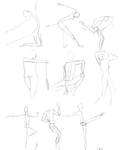So, how do you practice art when such a broad range of options are available? Here are some of the resources and exercises I've found really helpful:
1. Practice Gesture Drawings
Gesture drawings are short, timed sketches of a particular pose. The idea is to get the action or the movement of the figure down as quickly as possible without going back and erasing and perfecting every little section. There's a decent wiki guide to starting gesture drawing here. I've found that gesture drawing helps most with increasing the speed of your drawing. As I've progressed over the months I've seen huge changes in just how much detail I can get down in the same period of time. It also helps to loosen you up, and is a great exercise to use as a warmup. Most of my gestures start out stiff and angular and progress to smooth, more regular shapes by the end of the session. Best of all, they don't take long! You can set the timer for as long as you like (I typically use 60 seconds) and it only takes 10 minutes of drawings to see improvement. Here's the progress my daily gesture drawings have made in just 7 months:

(Note how the figures in the top left corner are stiff and get progressively more fluid)
For pose randomisers and gesture drawing tools, try the following resources:
Pixelovely - Also has a tool for hand, feet and expressions.
SketchDaily - Built for the subreddit /r/sketchdaily. A good tool, but I find some of the images a bit distasteful.
Senshistock - Using pose references from the supremely talented
2. Watch other people draw
This sounds counter-intuitive at first, seeing as it doesn't involve actually drawing, but there's so much that you can learn just from watching talented artists sketch. Look up video tutorials of particular body parts and sketch alongside it. One of my personal favourites is3. Do studies
Not studies like in a classroom, but studies on particular objects, body parts or aspects. Take the object of your study and examine it in depth. Draw it from every angle, examine how the light falls on that object, pull it apart piece by piece (er...visually, not literally. Don't go around ripping lamps apart or anything) and look at each component. What sort of variations exist? Become the master of that particular thing and continually add more and more things to your masteries!4. Make a list of things you want to improve
...and knock them off, one at a time! Be specific, not too general. Instead of writing "environment", for example, write "drawing snow" or "waterfalls" or "volcanoes" or whatever! I'm not saying you should sit down and write every single thing you want to improve at because, dear god that'd be a long list5. Repetition, repetition, repetition
A big mistake that a lot of beginner artists do is follow a tutorial, end up with something pretty nice and then stop. If you follow some great tutorial and it takes you half an hour to complete the drawing that's not the point to stop. You're not done! If it takes half an hour to draw that one thing, you need to improve that time. Draw the same thing, over and over and over again. Your speed will improve, your technique will improve and you'll become much more confident when drawing that particular thing. Eventually you'll be able to do it without thinking or stressing about something being wrong and checking back against the tutorial. At this point you can start to experiment and manipulate aspects of it and that's the first step towards developing a particular style!Of course, the obvious thing here is to actually DRAW, although I'm sure you didn't need to be told that
Do you have any other ways that you practice drawing? Share them below!